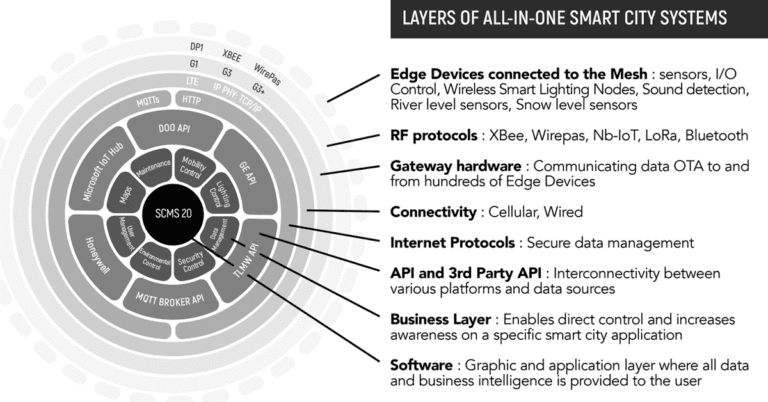Dimonoff is honoured to be named the 2025 Green Tech Award winner in the Smart City Lighting category by Digi International.
The Needle in the Smart City Haystack
Anyone trying to choose a smart city system supplier today can quickly become overwhelmed. The market is vast and highly fragmented, with many players from different industries offering some parts of what could become a smart city system.
Here is a list of what we understand are the different types of vendors on the smart city market.
Hardware (Device) Suppliers
In the world of street lighting for example, the hardware vendors are the traditional lighting companies that manufacture or sell luminaires, drivers or lamp poles. For other smart city applications, these suppliers would be parking meter companies, traffic light manufacturers, etc. Many of these vendors have recently begun offering solutions beyond the hardware itself such as sensors or controls compatible with their devices or even connectivity firmware integrated into the hardware.
Controls and Sensors Suppliers
These are companies selling control and sensors that make other devices “smart”. They usually make products for a wide variety of applications and sectors, for example energy management, air pollution, water leakage, traffic congestion, urban noise, parking management, etc. More and more we see them also offering some sort of control platform, either their own or from a third-party.
Software Vendors and Integrators
These companies usually come from the IT sector and develop the software and analytics tools to manage sensors and connected objects to provide packaged smart city systems. The software usually enables remote control of the hardware and sensors, device monitoring, data management and analytics. Their products usually promote data exchange and interoperability with other systems. Because they do not produce the hardware and sensors that create the physical layer of a smart city system, software vendors often act as integrators, helping clients select vendors for those missing parts and sometimes go as far as managing the implementation project. Sometimes integrators are consulting firms that do not make any of the pieces of the puzzle but help put it together.
Network Connectivity Vendors
Depending on the type of connectivity a city chooses for its smart city initiative, they may need to involve a connectivity vendor such as a telecommunication company. Commonly known as telcos, these companies can provide the connectivity for IoT devices, and traditional network connectivity vendors can supply routers and other equipment to connect the endpoint devices to the software.
All-in-one System Suppliers
All-in-one system suppliers offer all or most of a system’s components (like hardware, controls and sensors, software and connectivity). The components are usually somewhat customizable to fit projects and are sold bundled together as one system. Not many however offer solutions that allow managing multiple networks or multiple device manufacturers using one single user interface. To our knowledge, the Montreal smart street lighting project is quite unique in this regard. This technological feature ensures that the solution bought today will resist and even thrive alongside the inevitable advances and diversification of urban technologies.
Whether you choose any of these smart city system suppliers for parts or whole system, the analyst firm IDC notes that “Partnerships are common and required for vendors to provide full connectivity management”. Basically, smart city systems are a story of collaboration. It is really a matter of choosing the supplier that is right for you.
Smart City System Layers
A smart city system needs multiple layers of components in order to allow cities, utilities or private facility managers to deploy and benefit from many applications. On top of the lighting necessity, think about your needs in terms of mobility efficiency, environmental quality, public security and more. The needs are endless, and resources are not. Your system must be able to adapt and grow seamlessly and efficiently while limiting the number of tools to manage these new applications.
For example, the Dimonoff IoT architecture is designed in layers allowing you to add sensors, networks and even whole systems from 3rd parties, and can be used as an example of what ultimately a smart city system should look like.
The Right Smart City Supplier for You
You might be considering installing a smart application in your business, city or utility, and we know that choosing the right supplier can be overwhelming. The right type of supplier involved at the beginning of your project will undoubtedly help you get the results you want while allowing you to adapt to future needs and expectations.




















